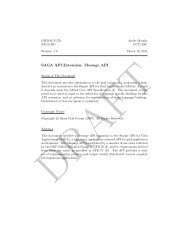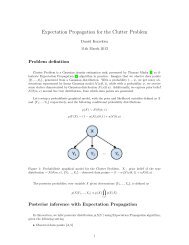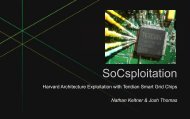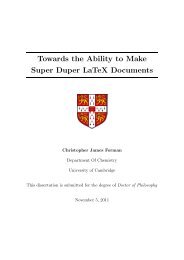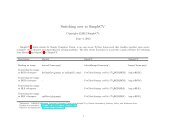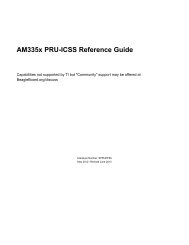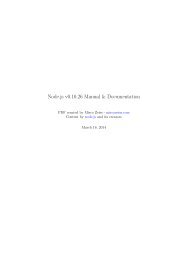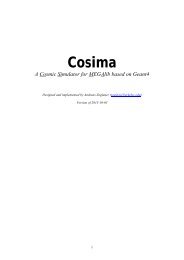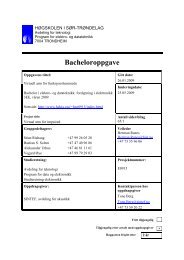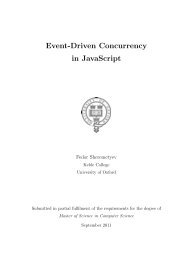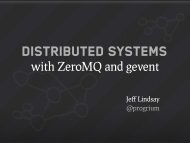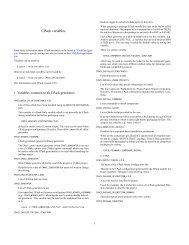SAGA: A Simple API for Grid Applications High-Level Application ...
SAGA: A Simple API for Grid Applications High-Level Application ...
SAGA: A Simple API for Grid Applications High-Level Application ...
Create successful ePaper yourself
Turn your PDF publications into a flip-book with our unique Google optimized e-Paper software.
2 COMPUTATIONAL METHODS IN SCIENCE AND TECHNOLOGYto computational biology, have developed their own <strong>API</strong>s tosimplify access to the grid <strong>for</strong> their application such as theParticle Physics Data <strong>Grid</strong> [6] and the Illinois Bio<strong>Grid</strong> [7].This momentum has culminated in the <strong>for</strong>mation of the <strong>Simple</strong><strong>API</strong> <strong>for</strong> <strong>Grid</strong> <strong><strong>Application</strong>s</strong> Research Group (<strong>SAGA</strong>-RG) withinthe Global <strong>Grid</strong> Forum (GGF).<strong>SAGA</strong> was founded at GGF11 in Hawaii, after successfulBoFs at GGF10 and GGF9 and originally chaired by membersof the <strong>Grid</strong>Lab, Globus/Python-CoG, and Reality<strong>Grid</strong> project.The aim of the group has been to identify a set of basic gridoperations and derive a simple, consistent <strong>API</strong>, which eases thedevelopment of applications that make use of grid technologies.The implementation of the <strong>SAGA</strong> <strong>API</strong> has been guidedby examination of the requirements expressed by existing andemerging grid applications in order to find common themesand motifs that can be reused across more than one use-case.The broad array of use cases that have been collected from thenascent grid application development community continues toplay a pivotal role in all design decisions.The next section describe the process which has been usedto derive the initial scope of the <strong>API</strong> in more detail, andalso documents general design principles applied to the initialimplementation. The <strong>SAGA</strong> <strong>API</strong> is then put in relation toother <strong>API</strong> related work in GGF, and also to projects withsimilar scope, such as the GAT and Globus-CoG. A moredetailed description of the current version of the <strong>SAGA</strong> <strong>API</strong>specification follows, including a number of explicit codeexamples.II. <strong>SAGA</strong>: GENERAL DESIGNThe original <strong>SAGA</strong> Research Group charter outlined asystematic approach to deriving the <strong>API</strong>: use case analysis,requirements analysis, and <strong>API</strong> development. <strong>API</strong> developmentwas further split into the creation of an abstract, languageindependent, specification, and then a set of language bindingscovering the major languages used in scientific applicationdevelopment — Fortran, C, C++, Java, Perl and Python. AtGGF12 in Brussels, it was suggested that a design teamshould be <strong>for</strong>med to rapidly proceed through the analysisprocess and produce a strawman <strong>API</strong> that could be used <strong>for</strong>further discussion and refinement into a final <strong>API</strong>. That <strong>SAGA</strong>Strawman <strong>API</strong> was supposed to be iterated against the use caserequirement analysis which was to be produced in parallel, inorder to stay true to the process outlined in the charter. 1A. Use Case AnalysisUpon creation, the <strong>SAGA</strong> group sent out a call <strong>for</strong> usecases, which resulted in 24 responses. These came froma wide range of applications areas, such as visualization,climate simulations, generic <strong>Grid</strong> job submission, applicationmonitoring and others. A large set of use cases (9) wassubmitted by the <strong>Grid</strong>RPC Working Group, which targets asimilar set of application in GGF (see section III-A).Common to the majority of the submitted use cases wastheir explicit focus on scientific applications (not surprising, as1 Currently, the <strong>SAGA</strong> group is undergoing a re-chartering process andtrans<strong>for</strong>ms into a Working Group, and is here referred to as <strong>SAGA</strong>-WG.almost all use cases came from the academic community). Fora discussion of non-scientific applications as <strong>SAGA</strong> customers,see subsection II-C.The analysis of the <strong>SAGA</strong> use cases focused on the identificationof the <strong>SAGA</strong> <strong>API</strong> scope, on the level of abstractionneeded and wanted by the application programmers, and onnon-functional requirements to the <strong>API</strong>, such as targetedprogramming languages, requirements to thread safety etc.Additional similar requirements are also drawn from otherprominent projects (such as listed in section IV), which alltook active participation in that <strong>SAGA</strong> group ef<strong>for</strong>t.B. The Design Team and the <strong>SAGA</strong> Strawman <strong>API</strong>In response to the suggestions at GGF12, the <strong>SAGA</strong> groupsent out a call and <strong>for</strong>med a design team, which met inDecember 2003 under the auspices of the Center <strong>for</strong> Computationand Technology, at Louisiana State University, BatonRouge, and at the Albert-Einstein-Institut, Golm, Germany,with an Access<strong>Grid</strong> link connecting the two halves of thedesign team, and allowing occasional outside participation.The major participants were Tom Goodale, David Konerding,Shantenu Jha, Andre Merzky, John Shalf, and Chris Smith,with Craig Lee, Gregor von Laszewski, and Hrabri Rajicproviding important input. This was followed in January of2004 by a meeting held at the Lawrence Berkeley Lab inBerkeley, Cali<strong>for</strong>nia, USA, also with an AG-Link to the VrijeUniversiteit, Amsterdam, Netherlands.Be<strong>for</strong>e embarking on developing the <strong>API</strong>s, a few generaldesign issues were considered and agreed upon.• The <strong>API</strong> would be developed and specified in an objectorientedmanner, using the Scientific Interface DescriptionLanguage (SIDL) to provide a language-neutral representation.The consensus was that it would be easier toprovide a mapping from an object-oriented representationinto a procedural language such as Fortran or C, than toprovide a mapping from a procedural representation intoan object-oriented language such as C++ or Java.• Any asynchronicity would be handled by a polling mechanismrather than a subscribe/listen mechanism. Thismakes the implementation in non-multi-threaded environmentsclearer, and avoids defining some mechanismto represent closures in non object-oriented languages.While both these things are possible — co-operativemulti-tasking using a call to a routine giving time toasynchronous tasks, and closures by use of a data-pointer,function-pointer pair — they would provide greater divergencebetween the different implementation languages.The team did not rule out future versions of the <strong>API</strong>from having such features 2 .• Each grid subsystem should be specified independentlyfrom other subsystems, and should not make use ofthem as far as possible. This allows the independentdevelopment and implementation of parts of the <strong>API</strong>, atthe cost of a small extra amount of complexity whenusing data derived from one part of the <strong>API</strong> in another,DRAFT2 But see notes to asynchronous notification below.
<strong>SAGA</strong> ET AL.: THE SIMPLE <strong>API</strong> FOR GRID APPLICATIONS 3such as when opening a logical file <strong>for</strong> remote file access,which requires the retrieval of the location of the logicalfile from the replica catalog, using one system, and theusing the File <strong>API</strong>s to open it. The team decided thatthe extra complication did not outweigh the advantagesgained by the semantic simplicity of defining thingsseparately, and the ability to to implement each subsystemindependently of other subsystems. It is possible thatfuture versions of the <strong>API</strong> may have bridging calls tosimplify some uses of the <strong>API</strong>s, however these would bebuilt upon the underlying subsystems, thus not breakingtheir independence.The design team examined the use cases and extracted thekey areas which were crucial to a number of the use cases:• Sessions and Security. Security is essential <strong>for</strong> any gridapplications that run across multiple administrative domainsor security boundaries. In <strong>SAGA</strong>, security is managedwith the notion of a session.• Data Management. This can take many <strong>for</strong>ms but remotefile access is a common requirement <strong>for</strong> many gridapplications. The team also tackled replica catalogs [8],as it was decided that the technology was sufficientlymature and the interfaces were sufficiently similar to filesto make this reasonable.• Job Management. The concept of remote job startup isa very common requirement. Asynchronous operationswere also found to be an important paradigm <strong>for</strong> remotegrid operations and, hence, are represented as tasks in theinitial <strong>SAGA</strong> Strawman <strong>API</strong>.• Inter-process Communication. <strong>SAGA</strong> supports interprocesscommunication with a stream concept that issimilar to BSD sockets.These key areas are discussed in detail in Section V.As the <strong>SAGA</strong> <strong>API</strong> requirement definition work are per<strong>for</strong>medin parallel to the <strong>SAGA</strong> Strawman <strong>API</strong> definition work(see below), the <strong>SAGA</strong> group faces the additional task to iteratethe <strong>SAGA</strong> Strawman <strong>API</strong> against these requirements. Thatprocess is currently underway, and seems to yield promisingresults: those use cases already evaluated seem to be easilyimplementable with the current <strong>API</strong> definition, as long asthe scope matches. However, that scope match is definitelyincomplete. In particular, several use cases miss the ability of<strong>SAGA</strong> to provide asynchronous notification. That feature isthere<strong>for</strong>e planned to be integrated into the <strong>API</strong> draft soon.C. <strong>SAGA</strong> and Non-Scientific <strong><strong>Application</strong>s</strong>As has been discussed in the previous subsection II-A, it ispossible that the <strong>SAGA</strong> Strawman <strong>API</strong> reflects a perceived biastowards scientific application. <strong>SAGA</strong> requirements, goals anddesign are use-case driven. Given that till the time of writingof this report, the <strong>SAGA</strong>-WG had received use cases from onlythe scientific community, it is natural that <strong>SAGA</strong> does reflectthis bias – it is not intentional but an artifact of the set of usecases received. Indeed, <strong>SAGA</strong> does not by definition constrainitself to scientific applications only. It is undeniable thatthe need <strong>for</strong> well-designed <strong>API</strong>s goes well beyond scientificcomputing. The recent, very popular phenomenon of Googlemashing is possible due to well designed and simple <strong>API</strong>sthat are openly publicized by Google [9] – thus enablingmash-up application developers to use Googles’ capabilitieswithout ever having to worry about the complex and in thiscase proprietary underlying technology and implementation.In many ways, this is precisely the philosophical aim of a<strong>Simple</strong> <strong>API</strong> <strong>for</strong> <strong>Grid</strong> <strong><strong>Application</strong>s</strong>. Admittedly, the <strong>API</strong> <strong>for</strong>Google mash-ups isn’t strictly a grid <strong>API</strong>, but the argument infavor of simple <strong>API</strong> <strong>for</strong> grid applications is still valid. What is,however, unclear at the time of writing is, if the same “<strong>Simple</strong>”<strong>API</strong> will be equally effective in both domains of scientificcomputation and commercial grid applications. As part of theexercise of determining that any eventual <strong>Simple</strong> <strong>API</strong> is ofuse in both areas as well as the initial first steps in thisdirection – direct and indirect – the <strong>SAGA</strong>-WG has, i) askedother relevant groups at the GGF <strong>for</strong> further “non-scientificcomputing” use-cases, and ii) agreed to work more closelyto ensure compatibility with groups involved in developingrelevant middleware, such as OGSA [10]. As these middlewaregroups have in turn received input from both communities,<strong>SAGA</strong> will hopefully benefit indirectly.III. <strong>SAGA</strong> IN GGF<strong>SAGA</strong> has ties to a number of other groups in GGF. In fact,a significant part of the <strong>SAGA</strong> input and motivation originatesin the work of other GGF groups. This sections lists the mostimportant of these groups, and shortly describes their relationto the <strong>SAGA</strong>-WG.A. DRMAA-WGThe DRMAA Working Group [11] at GGF produced a <strong>API</strong>specification <strong>for</strong> the submission and control of jobs to one ormore Distributed Resource Management (DRM) systems. Thescope of this specification is all the high level functionalitywhich is necessary <strong>for</strong> an application to consign a job toa DRM system, including common operations on jobs liketermination or suspension. The objective is to facilitate thedirect interfacing of applications to today’s DRM systemsby application’s builders, portal builders, and IndependentSoftware Vendors (ISVs) [12].DRMAA and <strong>SAGA</strong> groups have enjoyed several years ofactive collaboration. While the motifs of the <strong>SAGA</strong> peoplewere not to reinvent the wheel (i.e. the DRMAA <strong>API</strong>), theDRMAA people had an interest in independent scrutiny of its<strong>API</strong> ef<strong>for</strong>ts, in particular <strong>for</strong> job submission and job states.Both groups have a goal of a common base <strong>API</strong> whichprovides an easy transition <strong>for</strong> application developers movingfrom DRM systems or traditional Compute centers to the<strong>Grid</strong> systems or vice versa. DRMAA has passed its workexperience during the <strong>SAGA</strong> Strawman <strong>API</strong> deliberations andhas participated in many <strong>SAGA</strong> group initiatives, while atthe same time attracting <strong>SAGA</strong> principals’ participation in itssessions. Currently, the job submission part of the <strong>SAGA</strong> <strong>API</strong>draft reflects the DRMAA <strong>API</strong> very closely.DRAFT
4 COMPUTATIONAL METHODS IN SCIENCE AND TECHNOLOGYB. <strong>Grid</strong>RPC-WGThe <strong>Grid</strong>RPC <strong>API</strong> [13] represents ongoing work to standardizeand implement a portable and simple remote procedurecall (RPC) mechanism <strong>for</strong> grid computing. This standardizationef<strong>for</strong>t is being pursued through <strong>Grid</strong>RPC WorkingGroup at GGF. The initial work in that group showed thatclient access to existing grid computing systems such asNetSolve [14], Ninf [15], and DIET [16], can be unified via acommon <strong>API</strong>, a task that has proven to be problematic in thepast. The group successfully created such an <strong>API</strong> specification,which is now a GGF Draft Recommendation [17].The cooperation with the <strong>SAGA</strong>-WG allows the <strong>Grid</strong>RPC-WG to broaden the target user community <strong>for</strong> <strong>Grid</strong>RPCsignificantly, and would also equip the <strong>Grid</strong>RPC <strong>API</strong> witha look & feel which is compatible with the one used <strong>for</strong> othergrid programming paradigms. For example, the model <strong>for</strong>asynchronous calls used <strong>for</strong> RPCs will match the model <strong>for</strong>asynchronous calls of other paradigms, e.g. remote file access.C. <strong>Grid</strong>CPR-WGGGFs <strong>Grid</strong> Checkpoint and Recovery (<strong>Grid</strong>CPR) WorkingGroup [18] is devising an architecture <strong>for</strong> checkpointing longrunning applications <strong>for</strong> later recovery, possibly on differentgrid resources. <strong>Grid</strong>CPR use cases include fault resilience,intermittent operation (using small time slices until final completion),as well as parameter space exploration using various,related checkpoints.The currently envisioned architecture encompasses services<strong>for</strong> authentication/authorization, job management, checkpointstate management, checkpoint transfer, and event handling.<strong><strong>Application</strong>s</strong> are supposed to use a <strong>Grid</strong>CPR library, providingan <strong>API</strong> to these services. Details of this <strong>API</strong> arecurrently under investigation. As several concepts are similarto those defined by the <strong>SAGA</strong> <strong>API</strong> (copy/move checkpointfiles, read/write data, find files etc.), compatibility with <strong>SAGA</strong>is desired. That would provide application programmers witha more complete and consistent interface to the grid relatedcapabilities offered by the <strong>API</strong>s.D. OGSA-WGThe Open <strong>Grid</strong> Services Architecture (OGSA) WorkingGroup at GGF defines a Web Service based architecture whicheventually will be the overarching design principle <strong>for</strong> all gridservices. The problem space targeted by the OGSA group atfirst seems unrelated to the <strong>SAGA</strong> ef<strong>for</strong>t but, in fact, representsthe class of service-oriented, middleware architectures thatcould be the target plat<strong>for</strong>m <strong>for</strong> many <strong>SAGA</strong> implementations.Such service-oriented architectures address many issues, suchas resource naming, state management, and security, that willrequire a simplified mapping into the <strong>SAGA</strong> <strong>API</strong>. Hence, the<strong>SAGA</strong>-WG is in active communication with the OGSA groupand other OGSA-related ef<strong>for</strong>ts to ensure the proper levelof compatibility by cross-reviewing their respective standarddocuments and by providing <strong>SAGA</strong> reference implementationson OGSA-based middleware systems.E. Other GGF Working GroupsThe <strong>Grid</strong> File Systems (GFS) Working Group [19] targetsthe definition of a architecture which integrates physical filesystems into a single global, uni<strong>for</strong>m name space [20]. The<strong>SAGA</strong>-WG uses the definitions <strong>for</strong> name spaces defined bythe GFS-WG, and hence has the same notion of files anddirectories as that group.The Byte-IO Working Group [21] defines an OGSA compatibleservice which allows <strong>for</strong> efficient remote access tobinary data, e.g. files. Also, the <strong>Grid</strong>FTP Working Group [22]defined extensions to the standard FTP protocol which allows<strong>for</strong> efficient memory-to-memory and disk-to-disk data transferin grids. Both groups invest significant time in exploringparadigms <strong>for</strong> efficient remote data access. These paradigmsare partially reflected by the <strong>SAGA</strong> <strong>API</strong>.The JSDL Working Group [23] defines a XML based JobSubmission and Description Language. Although the <strong>SAGA</strong><strong>API</strong> currently refrains from any explicit usage of XML, thekeywords used <strong>for</strong> the <strong>SAGA</strong> job descriptions reflect thosedefined by JSDL.The Persistent Archive (PA) Research Group [24], DataReplication (REP) Research Group [8] and the OGSA ReplicaServices (OREP) Working Group [25] have all worked onthe services that manage distributed data files <strong>for</strong> data grids.Their work [26] is reflected in the <strong>SAGA</strong> Logical File <strong>API</strong>,which adopts the concept of logical files (or ’replicas’) thatwas defined by these groups.IV. RELATED WORKThe work on the <strong>SAGA</strong> <strong>API</strong> is not an isolated ef<strong>for</strong>t, butbuilds on top of a number of previous projects targeting thesame problem space. The Globus-CoG is probably the mostprominent representative of an <strong>API</strong> which tries to specificallyabstract the Globus package. The GAT from the EU-<strong>Grid</strong>Labproject targets already a more general abstraction of gridparadigms, and follows similar design principles as <strong>SAGA</strong>.Other projects such as Reality<strong>Grid</strong> and Data<strong>Grid</strong>/EGEE/LHCtarget the same problem space, but with interfaces withstronger focus on specific community needs. This sectiondescribes these ef<strong>for</strong>ts and their influence on <strong>SAGA</strong> in somedetail. In general, the <strong>SAGA</strong>-WG can be seen as the “GrandUnification” of all these grid <strong>API</strong>s, which provides a moreuni<strong>for</strong>m, middleware independent and standardized solution<strong>for</strong> grid application programmers.DRAFTA. GATThe design of the Strawman <strong>API</strong> and the ongoing workon a <strong>SAGA</strong> engine implementing this Strawman <strong>API</strong> is verymuch influenced by the experiences collected with the <strong>Grid</strong><strong>Application</strong> Toolkit (GAT [3]).Figure 1 shows the GAT architecture. It mainly distinguishesbetween user space and capability space. In user space runsthe application code that has been programmed using the GAT<strong>API</strong>. The GAT engine is a lightweight layer that dispatchesGAT <strong>API</strong> calls to service invocations via GAT adaptors.Adaptors are specific to given services and hide all servicespecificdetails from the GAT. A GAT engine typically loads
<strong>SAGA</strong> ET AL.: THE SIMPLE <strong>API</strong> FOR GRID APPLICATIONS 5Fig. 1.<strong>Application</strong>GAT <strong>API</strong>GAT EngineGAT Adaptors<strong>Grid</strong>Lab ServicesUnicore ServicesGlobus Services<strong>Grid</strong> Fabric LayerThe GAT framework software architecture.<strong>Application</strong> LayerGAT LayerService LayerCore Layeradaptors dynamically at runtime, whenever a certain serviceis needed. The GAT functionality is grouped into various, socalledsubsystems such as• The GAT Base Subsystem which defines general objectsand methods, supporting interaction with the GAT engine.• The Data Management Subsystem which covers threeareas: interprocess communication, remote file access,and file management.• The Resource Management Subsystem which dealswith grid (compute) resources. It provides functions <strong>for</strong>both resource discovery and job management.• The Event and Monitoring Subsystem which allowsapplications to send and receive events, such as eventsgenerated by a grid monitoring service.• The In<strong>for</strong>mation Management Subsystem which connectsto a generic grid in<strong>for</strong>mation system.• The Utility Subsystem which contains a number ofclasses providing general, convenience, and/or utilityorientedmethods.An engine may load multiple adaptors implementing thesame subsystem at the same time. For example, one adaptorcan give access to a local file system while another one givesaccess to files via <strong>Grid</strong>FTP [22], and a third one is using areplica catalog [27].While application and GAT together run in user space,the services are executed in the capability space, which canbe distributed across the machines of a Virtual Organization(VO [28]), including the one running the application. Thecapability space consists of the resources themselves, and themiddleware providing services to access them.The GAT <strong>API</strong> has been designed using an object-based approach,trying to avoid dependencies on any specific languagebinding [29]. However, <strong>for</strong> each supported application programminglanguage, a complete GAT layer has been provided,consisting of <strong>API</strong>, engine, and adaptors. Currently the GATsupports C, C++, Python and Java as target languages, whereUser Space Capability Spacethe C, C++ and Python implementations share the same engineand the same set of adaptors (regardless of the language theseare written in).The experience with the GAT showed, that the implemented<strong>API</strong> was partly too terse and too much oriented to synchronousoperation. The <strong>SAGA</strong> Strawman <strong>API</strong> tries to overcome thislimitation by defining a more complete set of functions dealingwith different aspects of grid related interfaces, such as fullernamespace support <strong>for</strong> file systems and by defining a dualinterface to all of the provided functionality, synchronouslyand asynchronously.B. Commodity <strong>Grid</strong>s (CoG) KitsThe Java CoG Kit [30] has over the years provided successfullyaccess to grid services through the Java framework. Componentsproviding client and limited server side capabilities areavailable. A subset of the Java CoG Kit is distributed with theGlobus Toolkit versions 3.0.2, 3.2, 3.9 and 4.0 as they use it.The Java CoG Kit significantly enhances the capabilities of theGlobus Toolkit by introducing grid workflows, control flows,and a task based programming model. A testing frameworkis available to conduct client side functionality tests. Portalsand Swing components are under development [4]. A Pythonversion of the CoG [31] does also exist, and has a significantuser base.The CoG kits have a very similar target user group as<strong>SAGA</strong>. Also, as the CoG kits are around and used sincea number of years by now, the accumulated feedback andexperience gathered by the projects is very valuable to the<strong>SAGA</strong> group. The group tries to include as much of thatknowledge as possible into its <strong>API</strong> design.C. Reality<strong>Grid</strong>Reality<strong>Grid</strong> is a UK e-Science pilot project that has usedgrid-based computational steering <strong>for</strong> a wide range of scientificapplications Computational steering as used by Reality<strong>Grid</strong>is defined as any mechanism that enables the control of theevolution of a computation, based upon the real time analysisand visualization of the status of a simulation, as opposed tothe post facto analysis and visualization of the output of acomputation. The functionality referred to as computationalsteering enables the user to influence the otherwise sequentialsimulation and analysis phases by merging and interspacingthem. The innovative use of computational steering andinteractive simulations on a grid of high-end resources hasshown to be effective in solving scientific problems [32], [33],which probably couldn’t be otherwise. The use of grid-basedcomputational steering <strong>for</strong> scientific problems has amongstthings raised a need <strong>for</strong> user-level control and thus <strong>API</strong>srelated to advanced reservations, co-allocation of resourcesand the interaction of grid-middleware with optical controlplanes.Providing <strong>for</strong> all of these needs is well outside of thescope of initial ef<strong>for</strong>ts of <strong>SAGA</strong> Strawman <strong>API</strong>, but a <strong>SAGA</strong>style look-and-feel <strong>API</strong> which does address these requirementswill eventually be required by the scientific grid-computationalscientist.DRAFT
6 COMPUTATIONAL METHODS IN SCIENCE AND TECHNOLOGYD. gLite and othersA number of more domain-specific interfaces exist whichtry to shield application developers from the complexities anddynamic behavior of grid middleware in that domain. Notablyamongst these interfaces is gLite’s ’<strong>Grid</strong> Access Service’(GAS) [34]. Similar to <strong>SAGA</strong>, the GAS defines a Servicewhich provides a simplified, stable and abstract interface to thecomplete gLite middleware infrastructure. Despite its differingarchitectural approach, the goals and scope of the GAS is verysimilar to the <strong>SAGA</strong> ef<strong>for</strong>t, and are considered as valuableinput to the <strong>SAGA</strong> design.V. <strong>SAGA</strong> DETAILSAs of October 2005, the <strong>SAGA</strong> <strong>API</strong> specification is convergingtoward a coherent document. The intended scopeseems well covered, and the use cases which have beenmotivating that scope seem to be well implementable withthe current <strong>API</strong> version. <strong>SAGA</strong> endeavors to provide the gridapplications programmer with a common look & feel across allfunctional areas. Any potential future extensions of the <strong>SAGA</strong><strong>API</strong> will inherit the same look & feel and so <strong>for</strong>m an integraland easy to learn new parts of the <strong>API</strong>.This section describes the <strong>API</strong> in its current state in somedetail, and shows examples of its usage. However, this descriptionand the examples are not meant to be normative, andwill with some certainty differ in many details from the final<strong>SAGA</strong> <strong>API</strong> specification, which is expected in 2006.A. Session Handling and SecurityAn essential part of the <strong>SAGA</strong> programming model is<strong>for</strong>med by the <strong>API</strong>’s session management and security handling.In order to keep the <strong>API</strong> usage simple and transparentto the application, however, any session and security handlingis optional. A default session handle is used if no explicithandle is specified, and a <strong>SAGA</strong> implementation is requiredto initialize available default security tokens as available, e.g.,the default Globus certificate is to be used if it is found in itsstandard location.However, if required, an application can create multipleindependent session handles. To each of these sessions, explicitsecurity tokens (called context in <strong>SAGA</strong>) can be attached.Any <strong>SAGA</strong> object creation and method invocation can thenassociated with that session handle, and is required to use thespecified security tokens. The code example in Figure 2 showshow to access a remote file using a myproxy login.B. Data ManagementRemote data access and management certainly belong tothe most understood and most widely used paradigms indistributed environments. <strong>Grid</strong>s however apply subtle changesto the well known remote paradigms, which need to bereflected in the <strong>SAGA</strong> <strong>API</strong>. The data management parts ofthe <strong>API</strong> are hence a blend of well known paradigms (suchas POSIX like directory navigation) and new grid paradigms(such as replica management).Fig. 2.Code Example: Session and Security Handling in <strong>SAGA</strong>#include #include void sample_session (){try{// create a <strong>SAGA</strong> session handlesaga::session s;// create a myproxy context ...saga::context c (saga::context::MyProxy);// ... and fill itc.set_attribute ("username", "andre");c.set_attribute ("password", "secret");// attach the context to the sessions.add_context (c);// create a file in that sessionsaga::file f (session,"gsiftp://ftp.host.net/pub/INDEX");// further code see later file examples}catch ( saga::exception e ){std::cerr
<strong>SAGA</strong> ET AL.: THE SIMPLE <strong>API</strong> FOR GRID APPLICATIONS 7Fig. 3.Code Example: Create a remote directory#include #include void sample_mkdir (){try{// open a remote directorysaga::directory d("gsiftp://ftp.host.net/pub/");}Fig. 4.// create a new subdirectoryd.mkdir ("data/");}catch ( saga::exception e ){std::cerr
8 COMPUTATIONAL METHODS IN SCIENCE AND TECHNOLOGYalso be queried <strong>for</strong> its current state, error conditions etc. Inputand output data files and streams are, if required, defined inthe job description.In order to further simplify the job submission, a job servicealso offers a job run method, which requires only the essentialjob in<strong>for</strong>mation to be given, and creates the job descriptioninternally. The call returns the standard input, output and errorstreams <strong>for</strong> the remotely run job. The code example in Figure 6illustrated the usage of the job run method in Perl.Fig. 6. Code Example: Start a remote /bin/date, and retrieve output (just<strong>for</strong> a change, that example is given in Perl)#!/usr/bin/perl -wBEGIN {use strict;use saga;}eval {# create job servicemy $js = new saga::job_service ();# and submit a jobmy ($job, IN, OUT, ERR)= $js.runJob ("ssh.university.edu","/bin/date");# print any job outputwhile ( $job.getJobState () !˜ /ˆDone/io ){print STDOUT ;print STDERR ;}# status is ’Done’ here};# catch all saga exceptionif ( $@ =˜ /ˆsaga/io ){die "saga error: $@\n";}2) Tasks: To manage the potentially large latencies ingrid environments, <strong>SAGA</strong> introduces an asynchronous Taskmodel. For each synchronous method call (e.g. file.read(target)), that model introduces a asynchronous counterpart(file.asynch.copy (target)). That asynchronousmethod call returns a saga::task object, whichoffers methods to watch the state and progress of the operation,and to cancel it if required. The code example in Figure 7shows the <strong>SAGA</strong> task model applied to a remote mkdiroperation 3 .The <strong>SAGA</strong> Task Model does also include a container class<strong>for</strong> tasks, which allows to handle large numbers of task objectsefficiently (e.g. wait <strong>for</strong> all of them to complete). There areconsiderations to extend that task model by allowing to havedependencies between tasks, and so to effectively introduceworkflow, but we consider such extensions to be out of scope<strong>for</strong> <strong>SAGA</strong> <strong>for</strong> now.3 It must be noted that the <strong>SAGA</strong> Task Model is currently under discussion,and might change to some extend (without loss of functionality). So theexample given here should be considered very preliminary.Fig. 7. Code Example: asynchronous version of the remote mkdir example:This example should be compared to the synchronous version in Figure 3.#include #include void sample_async_mkdir (){try{// open a remote directorysaga::directory d("gsiftp://ftp.host.net/pub/");// create a mkdir tasksaga::task t = d.async.mkdir ("data/");// showing the task stateif ( saga::task::Running == t.get_state () ){std::cout
<strong>SAGA</strong> ET AL.: THE SIMPLE <strong>API</strong> FOR GRID APPLICATIONS 9Fig. 8.Code Example: Create a streaming clientFig. 9.Code Example: Potential RPC representation in <strong>SAGA</strong>#include int main (int argc, char** argv){// create stream to server contact in argv[1]saga::stream s (argv[1]);}// open the connections.connect ();// message to write in argv[2]s.write (argv[2]);// the stream gets destroyed at and of scope,// connection is closed in destructorE. Possible <strong>SAGA</strong> Extensions (Future Work)As described above, the current scope of the <strong>SAGA</strong> <strong>API</strong>specification is intentionally very limited, and drawn from afinite set of use cases. However, the <strong>SAGA</strong>-WG has receiveda number of requests to widen the scope of the <strong>API</strong>, and anumber of additional use cases <strong>for</strong> the respective areas havebeen submitted. <strong>SAGA</strong> is intended to follow up with theserequests in future versions of the specification. This sectionallows the reader a glimpse of the <strong>SAGA</strong> future, and describesthese extensions. It must be noted though that all materialdescribed here is very preliminary, and represents by no meansany part of the current <strong>SAGA</strong> specification.1) Monitoring and Steering: The ability to monitor remoteapplications (and in fact any remote grid resource) is integralpart of a number of received use cases. <strong>SAGA</strong> currently onlyallows polling of specific monitorables, such as the state ofjobs and tasks. <strong>Application</strong> level monitoring and steering iscurrently not supported. A number of use cases have beensubmitted to the group though, which require monitoring andsteering, in particular in the context of visualization.The UK-eScience project ‘Reality<strong>Grid</strong>’ [5] designed andimplemented a grid monitoring and steering infrastructure[36]. The Reality<strong>Grid</strong> Steering <strong>API</strong> has been used acrossa wide range of different scientific applications — rangingfrom classical molecular dynamics, lattice-Boltzmann simulationsand Monte-Carlo simulations of polymers — providingtestimony to its flexibility and breadth. Together withthe monitoring capabilities of GAT (which derive from themonitoring package Mercury [37]), the Reality<strong>Grid</strong> <strong>API</strong> willprobably <strong>for</strong>m the basic input <strong>for</strong> a future <strong>SAGA</strong> monitoringand steering <strong>API</strong>.2) Remote Procedure Calls: As described in section III, the<strong>Grid</strong>RPC Working Group in GGF defined another applicationoriented <strong>API</strong>, which provides Remote Procedure Calls (RPCs)in grid environments. The <strong>Grid</strong>RPC-WG and the <strong>SAGA</strong>-WGstarted to actively pursue the integration of <strong>Grid</strong>RPC into<strong>SAGA</strong>. That would provide a consistent look & feel <strong>for</strong> both<strong>API</strong>s, and provide grid application programmers with a morecomplete and more consistent set of programming paradigms.An example <strong>for</strong> the current candidate <strong>API</strong> extension is shownin Figure 9.#include #include #include void sample_rpc (){try{// initialize rpc function handlesaga::rpc handle("gridrpc://remote.host.net/bin_date");// initialize in/out argument stackstd::list stack;// call the remote functionhandle.call (stack);std::cout
10 COMPUTATIONAL METHODS IN SCIENCE AND TECHNOLOGYIn order to produce a usable <strong>API</strong> specification timely (theperceived need <strong>for</strong> that <strong>API</strong> is continually increasing), a designteam was <strong>for</strong>med in side the <strong>SAGA</strong>-WG. That design teamdrafted the <strong>SAGA</strong> Strawman <strong>API</strong>, which is currently underscrutiny to check its suitability <strong>for</strong> the <strong>SAGA</strong> use cases. Thisarticle has presented the <strong>SAGA</strong> Strawman <strong>API</strong> and illustratedthe simplicity of its usage with a number of code examples.The future work of the group is to finalize the <strong>API</strong> specification,to support the various ongoing reference implementationef<strong>for</strong>ts, and to later expand the scope of the <strong>SAGA</strong> <strong>API</strong> toother relevant areas covered by the respective use cases.ACKNOWLEDGMENTSThe presented work is the result of a very large communityef<strong>for</strong>t, and the number of involved people is way too largeto list them all individually. That list includes a large numberof application developers which provided input to the <strong>SAGA</strong>Working Group in <strong>for</strong>m of use cases. The input and discussionswith the other working groups in GGF has been crucial tothe successful design and scoping of the <strong>SAGA</strong> <strong>API</strong>. Thedesign team, whose members have already been mentioned,have invested significant time and ef<strong>for</strong>t to draft the current<strong>SAGA</strong> <strong>API</strong>. All projects listed in the related work section,funded by a large and diverse set of institutions and fundingagencies, have been in close contact with the <strong>SAGA</strong> ef<strong>for</strong>t, andactively participated in shaping the <strong>SAGA</strong> <strong>API</strong>. The <strong>SAGA</strong>Working Group wants to thank all of them.REFERENCES[1] GGF. (2004) <strong>Simple</strong> <strong>API</strong> <strong>for</strong> <strong>Grid</strong> <strong><strong>Application</strong>s</strong> Research Group.[Online]. Available: http://<strong>for</strong>ge.grid<strong>for</strong>um.org/projects/saga-rg/[2] G. Allen, K. Davis, K. N. Dolkas, N. D. Doulamis, T. Goodale,T. Kielmann, A. Merzky, J. Nabrzyski, J. Pukacki, T. Radke, M. Russell,E. Seidel, J. Shalf, and I. Taylor, “Enabling <strong><strong>Application</strong>s</strong> on the <strong>Grid</strong>– A <strong>Grid</strong>Lab Overview,” International Journal on <strong>High</strong> Per<strong>for</strong>manceComputing <strong><strong>Application</strong>s</strong>, vol. 17, no. 4, pp. 449–466, 2003.[3] G. Allen, K. Davis, T. Goodale, A. Hutanu, H. Kaiser, T. Kielmann,A. Merzky, R. van Nieuwpoort, A. Reinefeld, F. Schintke, T. Schütt,E. Seidel, and B. Ullmer, “The <strong>Grid</strong> <strong>Application</strong> Toolkit: TowardsGeneric and Easy <strong>Application</strong> Programming Interfaces <strong>for</strong> the <strong>Grid</strong>,”Proceedings of the IEEE, vol. 93, no. 8, pp. 534–550, 2005.[4] G. von Laszewski, I. Foster, J. Gawor, and P. Lane, “A Java Commodity<strong>Grid</strong> Kit,” Concurrency and Computation: Practice and Experience,vol. 13, pp. 643–662, 2001. [Online]. Available: http:/www.cogkit.org/[5] Reality<strong>Grid</strong> Project. (2005) The Reality<strong>Grid</strong> Project. [Online]. Available:http://www.realitygrid.org/[6] Particle Physics Data <strong>Grid</strong>. [Online]. Available: http://www.ppdg.net[7] Illinois Bio<strong>Grid</strong>. [Online]. Available: http://gridweb.cti.depaul.edu/twiki/bin/view/IBG/AboutIBG[8] GGF. (2004) Data Replication Research Group. [Online]. Available:http://<strong>for</strong>ge.grid<strong>for</strong>um.org/projects/jsdl-wg/[9] D. Darlin, “A Journey to a Thousand Maps Begin With an Open Code,”New York Times, Oct. 20th, 2005. [Online]. Available: http://www.nytimes.com/2005/10/20/technology/circuits/20maps.html?emc=%eta1[10] I. Foster et al., “The Open <strong>Grid</strong> Services Architecture, Version 1.0,”January 2005, http://www.ggf.org/documents/GFD.30.pdf.[11] GGF. (2003) Distributed Resource Management <strong>API</strong> Working Group.[Online]. Available: http://<strong>for</strong>ge.grid<strong>for</strong>um.org/projects/drmaa-wg/[12] H. Rajic, R. Brobst, W. Chan, F. Ferstl, J. Gardiner, A. Haas,B. Nitzberg, H. Rajic, and J. Tollefsrud, “Distributed ResourceManagement <strong>Application</strong> <strong>API</strong> Specification 1.0,” Global <strong>Grid</strong> Forum,Tech. Rep., June 2004, GFD.022. [Online]. Available: http://www.ggf.org/documents/GFD.22.pdf[13] K. Seymour, H. Nakada, S. Matsuoka, J. Dongarra, C. Lee, andH. Casanova, “An Overview of <strong>Grid</strong>RPC: A Remote Procedure Call<strong>API</strong> <strong>for</strong> <strong>Grid</strong> Computing,” in 3rd International Workshop on <strong>Grid</strong>Computing, vol. 2536. Springer-Verlag, Lecture Notes in ComputerScience, November 2002, pp. 274–278.DRAFT[14] D. Arnold, S. Agrawal, S. Black<strong>for</strong>d, J. Dongarra, C. Fabianek,T. Hiroyasu, E. Meek, M. Miller, K. Sagi, K. Seymour, Z. Shi,and S. Vadhiyar, “Users’ Guide to NetSolve V2.0,” The NetSolveProject, Innovative Computing Laboratory, Department of ComputerScience, University of Tennessee, Tech. Rep., 2004. [Online]. Available:http://icl.cs.utk.edu/netsolve/[15] Y. Tanaka, H. Nakada, S. Sekiguchi, T. Suzumura, and S. Matsuoka,“Ninf-G: A reference implementation of RPC-based programmingmiddleware <strong>for</strong> <strong>Grid</strong> computing,” Journal of <strong>Grid</strong> Computing,vol. 1, no. 1, pp. 41–51, ???? 2003. [Online]. Available: http://ipsapp009.kluweronline.com/content/getfile/6160/1/3/abstract.htm;http://ipsapp009.kluweronline.com/content/getfile/6160/1/3/fulltext.pdf[16] E. Caron and F. Desprez, “DIET: A Scalable Toolbox to Build NetworkEnabled Servers on the <strong>Grid</strong>,” International Journal of <strong>High</strong> Per<strong>for</strong>manceComputing <strong><strong>Application</strong>s</strong>, 2005, to appear.[17] K. Seymour, H. Nakada, S. Matsuoka, J. Dongarra, C. Lee, andH. Casanova, “A <strong>Grid</strong>RPC Model and <strong>API</strong> <strong>for</strong> End-User <strong><strong>Application</strong>s</strong>,”September 2005, http://www.ggf.org/documents/GFD.52.pdf.[18] GGF. (2003) <strong>Grid</strong> Checkpoint Recovery Working Group. [Online].Available: http://<strong>for</strong>ge.grid<strong>for</strong>um.org/projects/gridcpr-wg/[19] GGF. (2004) <strong>Grid</strong> File Systems Working Group. [Online]. Available:http://<strong>for</strong>ge.grid<strong>for</strong>um.org/projects/gfs-wg/[20] Resource Namespace Service - Proposed Final Draft v1.3 . [Online].Available: http://<strong>for</strong>ge.grid<strong>for</strong>um.org/projects/gfs-wg/document/Resource Namespace Service - Proposed Final Draft v1.3/en/2[21] GGF. (2004) ByteIO Working Group. [Online]. Available: http://<strong>for</strong>ge.grid<strong>for</strong>um.org/projects/byteio-wg/[22] ——. (2001) <strong>Grid</strong>FTP Working Group. [Online]. Available: http://<strong>for</strong>ge.grid<strong>for</strong>um.org/projects/gridftp-wg/[23] GGF. (2004) Job Submission and Description Language WorkingGroup. [Online]. Available: http://<strong>for</strong>ge.grid<strong>for</strong>um.org/projects/jsdl-wg/[24] GGF. (2003) Persistent Archives Research Group. [Online]. Available:http://<strong>for</strong>ge.grid<strong>for</strong>um.org/projects/pa-rg/[25] ——. (2004) OGSA Replication Services Working Group. [Online].Available: http://<strong>for</strong>ge.grid<strong>for</strong>um.org/projects/jsdl-wg/[26] R. Moore and A. Merzky, “Persistent Archive Concepts,” Global <strong>Grid</strong>Forum, Tech. Rep., December 2003, GFD.026. [Online]. Available:http://www.ggf.org/documents/GFD.26.pdf[27] <strong>Grid</strong>Lab Project. (2002) The Replica Management Service. [Online].Available: http://www.gridlab.org/data[28] I. Foster, C. Kesselman, and S. Tuecke, “The Anatomy of the <strong>Grid</strong>:Enabling Scalable Virtual Organizations,” International Journal of Supercomputer<strong><strong>Application</strong>s</strong>, vol. 15, no. 3, 2001.[29] K. Davis, T. Goodale, and A. Merzky, “GAT <strong>API</strong> Specification:Object Based,” EU Project <strong>Grid</strong>Lab, Deliverable D1.5, June2003. [Online]. Available: http://www.gridlab.org/WorkPackages/wp-1/Documents/<strong>Grid</strong>lab-1-GAS-0004.ObjectBased<strong>API</strong>Specification.pdf[30] G. von Laszewski, I. Foster, J. Gawor, and P. Lane, “A Java Commodity<strong>Grid</strong> Kit,” Concurrency and Computation: Practice and Experience,vol. 13, no. 8–9, pp. 643–662, 2001, http://www.cogkits.org.[31] D. C. D. Lawrence Berkeley National Laboratory, ComputationalResearch Division. (2005) Python Globus (pyGlobus). [Online].Available: http://dsd.lbl.gov/gtg/projects/pyGlobus/[32] S. Jha, P. V. Coveney, M. Harvey, and R. Pinning, “SPICE:Simulated Pore Interactive Computing Environment,” Proceedingsof ACM/IEEE Supercomputing Conference 2005, 2005,http://sc05.supercomputing.org/schedule/pdf/anal109.pdf.[33] “The TeraGyroid Experiment”, Accepted <strong>for</strong> GGF10<strong><strong>Application</strong>s</strong> Workshop. [Online]. Available: http://www.realitygrid.org/TeraGyroid-Case-Study-GGF10.pdf,http://www.realitygrid.org/TeraGyroid-Case-Study-GGF10.pdf[34] R. Berlich, M. Kunze, and K. Schwarz, “<strong>Grid</strong> computing in Europe: fromresearch to deployment,” in CRPIT ’44: Proceedings of the 2005 Australasianworkshop on <strong>Grid</strong> computing and e-research. Darlinghurst,Australia: Australian Computer Society, Inc., 2005, pp. 21–27.[35] S. D. Team. (2005) <strong>Simple</strong> <strong>API</strong> <strong>for</strong> <strong>Grid</strong> <strong><strong>Application</strong>s</strong> – Strawman <strong>API</strong>Version 0.2. [Online]. Available: http://wiki.cct.lsu.edu/saga/space/start/strawman-api-v0.2.pdf[36] S. Pickles, R. Pinning, A. Porter, G. Riley, R. pert Ford, K. Mayes,D. Snelling, J. Stanton, S. Kenny, and S. Jha, “The realitygrid computationalsteering api version 1.1,” Reality<strong>Grid</strong>, Tech. Rep., 2004, e-print.[37] P. Kacsuk, G. Dózsa, J. Kovács, R. Lovas, N. Podhorszki, Z. Balaton,and G. Gombás, “P-GRADE: A <strong>Grid</strong> Programming Environment,”Journal of <strong>Grid</strong> Computing, vol. 2, pp. 171–197, 2003.



